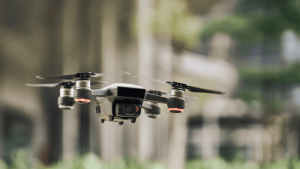Using drones in disaster management is improving the way natural disasters such as fires, earthquakes and floods are responded to. They enable rapid damage assessment, search and rescue of victims, and continuous monitoring of affected areas in real time.
Advantages of Using Drones in Disaster Response
When a natural disaster strikes, speed and accuracy are essential to save lives and efficiently coordinate rescue operations. 3 advantages of using drones in disaster management are:
- Inspection of inaccessible areas: After a disaster, drones can quickly fly to remote or collapsed areas to obtain information without the need to mobilize ground teams, speeding up initial damage assessment.
- Speed of response: Drones show us accurate and detailed data in real time on the status of affected infrastructure or areas. Their cameras and thermal sensors help us prioritize rescue tasks.
- Cost and risk reduction for rescue teams: Thanks to the use of unmanned aircraft as a tool in these situations, the human risk they must face in such dangerous conditions is minimized.
Drone Applications in Disaster Management
1. Rapid Damage Survey and 3D Mapping
In the aftermath of a disaster, immediate damage assessment is crucial to determine the extent of the impact and coordinate recovery efforts. Drones allow us to obtain high-resolution images of the affected areas, generating 3D maps that provide an accurate picture of the damage.
In addition, drones can identify critical areas in need of urgent attention, such as collapsed buildings or flooded areas, helping to allocate available resources more efficiently.
2. Search and Rescue of Victims
Sometimes, these disasters affect citizens, so search and rescue actions are required.
For this, thermal drones are the main protagonists, as they are equipped with infrared cameras that can locate people trapped in rubble or in areas difficult to access by detecting their body heat.
3. Continuous Update of Affected Areas
Their use is not limited only to the initial response phase. Drones can perform continuous monitoring of affected areas, providing up-to-date data on the status of infrastructure and ground conditions. This is vital in disasters such as wildfires or landslides, where conditions change rapidly and the rescue strategy needs to be adjusted.
In addition, drones can be integrated with artificial intelligence systems to analyze the data collected and detect problems in real time, such as gas leaks or instability of structures.



